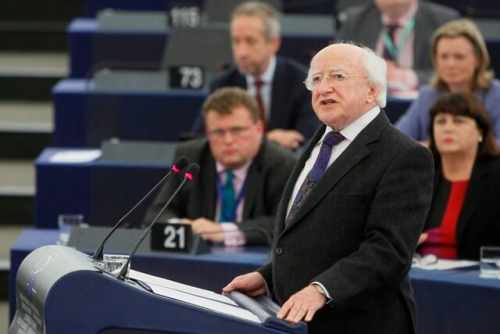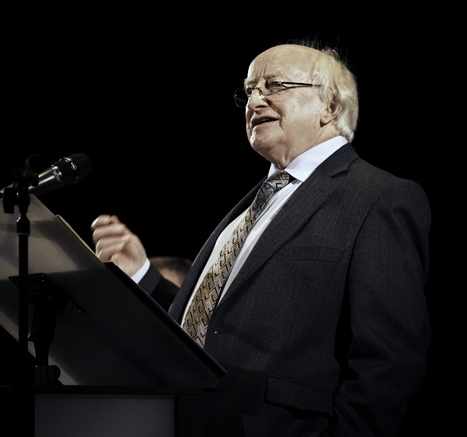Remarks at the Memorial To The Batallón De San Patricio
Plaza San Jacinto, San Ángel, Mexico City, 20th October 2013
Estimado Licenciado José Antonio Meade, Secretario de Relaciones Exteriores,
Estimado Sr. Leonel Luna Estrada, Delegado de la delegación Álvaro Obregón,
Miembros de la comunidad irlandesa,
Amigas y amigos,
Sabina y yo valoramos enormemente que se encuentren aquí esta mañana para rendir homenaje al valiente Batallón de San Patricio.
Me conmueve sobremanera poder reflexionar sobre las vidas de los hombres de ese Batallón, cuyos nombres se encuentran plasmados en la Plaza San Jacinto.
[Sabina and I appreciate very much that you have joined us here this morning to honour the valiant ‘Batallón de San Patricio.’
I am very moved to have this opportunity to reflect on the lives of the men of this battalion, whose names are inscribed here in the Plaza San Jacinto.]
The year 1847 has a very significant historical resonance in Mexico. The same year is also a most significant one in Ireland. Here in Mexico, 1847 is associated with the war with the United States. For an Irish audience, that year evokes the horrors of the Great Famine, which reached its nadir in 1847, or Black ’47, as it is referred to by many in Ireland.
This plaque was created in 1959 by the Mexican sculptor Lorenzo Rafael whose Irish wife Stephanie – with us here today – comes from Galway, the same county as
Captain John Riley.
Behind the Irish names listed on the plaque – names like Hanly, Delaney, Kelly, Murphy and Dalton, Riley’s second in command – there are individual trajectories, stories of exile, chosen or imposed. It is very poignant to be gathered here this morning to pay our respects to this gallant group, themselves in many ways the descendants of an earlier scattering of Irish men across the armies of Europe and its empires.
While little is known of these men’s individual stories, we can assume that they lived in tumultuous times; some may have travelled from Ireland; others from elsewhere in Europe. In making their journey across the Atlantic Ocean to the United States and then on to Mexico, they were seeking to escape hunger and poverty and to secure a better future.
Today the lives of migrants remain marked by an intense vulnerability, and the experience of emigration is one that has a deep resonance for the people of Ireland and Mexico. This sensitivity gives us a particular empathy towards the destiny of the men listed on this plaque – the survival they struggled for, the opportunities they pursued and the difficult choices that they made.
Historical accounts speak of the bravery of the Batallón de San Patricio, and of the tactical ability and experience of its leader, Captain John Riley. Riley, also known as O’Reilly, is commemorated in this Plaza with this bust donated by the Embassy of Ireland as a gesture of friendship between the people of Ireland and the people of Mexico.
In reflecting on the life of John Riley, we can also reflect on the experiences of all those who fought alongside him in the Batallón de San Patricio, or ‘los San Patricios’ as its soldiers were usually known.
Riley’s Battalion made its last stand at Churubusco. Popular historian Tim Pat Coogan tells us that the fighting lasted three hours and ended only when the San Patricios ran out of ammunition. Of the 204 San Patricios involved in Churobusco, military records show that 35 were killed and 85 were captured, with 70 subsequently condemned to death by hanging. Some sentences were commuted but the cruelty of the floggings and the brandings on the face were only exceeded by the brutal hangings at San Ángel in September 1847.
John Riley’s story of emigration echoes that of so many others who left Ireland in the 1840s, a time of great distress for the country. Riley left his native land to simply survive, to escape poverty and to seek a better life. He was from the West of Ireland, from Clifden in County Galway, an area I represented in the Irish Parliament for over 20 years.
Es conmovedor estar de pie hoy en el centro de la pujante y moderna Ciudad de México y considerar que Riley llegó aquí luego de zarpar desde una pequeña aldea en la costa atlántica de Irlanda, lo que me lleva a pensar en su resistencia y en el coraje que se necesita para adaptarse a circunstancias tan cambiantes.
[It is very moving to stand today in the centre of a thriving, modern Mexico City, to consider that Riley made his way here from that small village on the Atlantic coast of Ireland, and to reflect on the resilience and the courage that were required to adapt to his changing circumstances.]
With the outbreak of conflict between the US and Mexico, soldiers on both sides were deployed in harsh conditions. For the San Patricios this was not a new experience. Riley and his comrades who formed the Batallón de San Patricio were men who had already endured hardship, either in their homeland of Ireland or elsewhere in Europe. Historians suggest that, after arriving in the US, they found themselves the victims of discrimination based on a religious belief they shared with Mexicans and, instead of becoming the beneficiaries of the longed for hope and opportunity, they were pressed into service against co-religionists.
It was against this harsh backdrop that Riley decided to offer his services to the Mexican side, acting on an empathy that he and others who joined the San Patricios felt with the Mexican people. For this choice, the San Patricios were reviled and cruelly punished by one side in the conflict, but cherished and remembered by the other.
Now, more than 150 years later, we have thankfully moved from the animosity and the prejudices of that conflict. But the identification with the Mexican cause by ‘los San Patricios’ has created an unbreakable link between our two countries.
The San Patricios are solemnly remembered here each year in San Ángel, at the ‘Museo Nacional de las Intervenciones’ in Coyoacán, in Monterrey, in Saltillo and also in the county of Galway, which my family and I call home.
As the names of these soldiers are called out, the Irish and Mexican communities are brought together to reminisce and celebrate our shared history and to cherish our friendship which runs so deep.
The people of Ireland and Mexico share a similar cultural vibrancy that sees life as a joyful experience to be lived to the full. We also share a deep appreciation of our respective diasporas and the rich contribution that they have made, and continue to make, in their adopted homes as well as to their ‘patrias.’
The late Patricia Bustamante Cox, a first generation Irish-Mexican who wrote two books about the San Patricios, describing their bravery on the battlefields of Matamoros, Monterrey and Churubusco, noted that:
“México y Irlanda son tierras de santos, héroes y poetas que no necesitan acudir a la leyenda para hallar en su realidad cotidiana elementos suficientes para hacer de la vida una obra de arte, donde hay que entregarlo todo, incluso la vida”.
[Mexico and Ireland are lands of saints, heroes and poets who have no need to turn to legend to find in their everyday reality sufficient to convert life into a work of art, wherein all has to be given, even life itself”]


